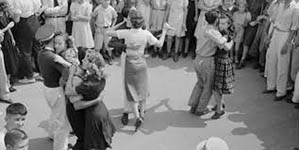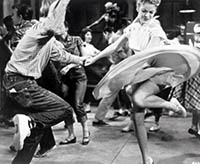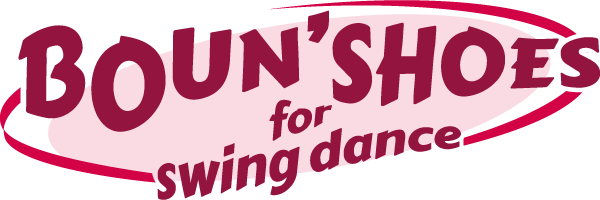A FASCINATING JOURNEY TO DISCOVER SWING DANCES
We have already seen how from the Breakaway and the Charleston came the Lindy Hop. (Read here)
We will now take a journey to discover the other dances that are part of the swing world, how they developed and their characteristics.
- A DIVE INTO THE BLUES, THE DANCE OF THE ORIGINS
- VINTAGE JAZZ, ALL POWER TO IMPROVISATION
- DREAMING OF CALIFORNIA: THE ELEGANCE OF BALBOA
- THE COLLEGIATE SHAG, FROM STUDENTS TO CARTOONS
- BOOGIE WOOGIE: FROM JUST STEPS TO ROCK & ROLL

A DIVE INTO THE BLUES, THE DANCE OF THE ORIGINS
Also at the turn of the 19th and 20th centuries was the development of the Blues, which could be danced both alone and in couples, with natural movements strongly linked to the earth and of course with a clear African influence, with a strong playful and joyful component. Initially, it was called Jookin and was danced in Juke joints, small places of recreation and rest for black workers: it had delta blues as its reference music; then, during the Swing Era, on decidedly larger dance floors, slow drag/ballroomin imposed itself, which had slow swing and a more jazzy form of blues as its reference music. As for the style, it is characterised by the 'close embrace' dance position, upright posture and wide strides.
VINTAGE JAZZ, ALL POWER TO IMPROVISATION
Vintage Jazz also has its origin in the culture of the first African-American communities settled in the Harlem area of New York. When one speaks of Vintage Jazz - also known as Vernacular, Authentic Jazz or sometimes as Original Jazz - one refers to the Jazz dance of the 1920s, 1930s and 1940s, which, unlike the contemporary 'modern jazz dance', was obviously not influenced by steps and techniques of later dances.
Vintage Jazz is danced solo and performed through improvisation or choreography. Its main characteristics are individuality and rhythm: each dancer is free to express his or her personality by developing an individual style. It is characterised by downward movements, i.e. it is centred on the use of the legs; this applies in particular to the Charleston Solo. The rest of the body gains in lightness, ending up giving the dancer a disenchanted and playful expression. The movements are on the whole very rhythmic and often influenced by Tip-tap.
If danced alone it can have this free and improvised style, its choreographies instead have codified and universally recognised names and characteristics in the Swing world, such as the Shim Sham Shimmy, the Big Apple and the Tranky Doo.
DREAMING OF CALIFORNIA: THE ELEGANCE OF BALBOA
 Between the 1920s and 1930s, the Swing dance 'bounced' from the East Coast to the West of the United States. From New York to Orange County in Southern California, where Balboa was born. The Balboa style takes its name from the Balboa Peninsula and in its original form (Pure Balboa or Pure-Bal) differs from the Lindy Hop in that it is danced in a fully closed, chest-to-chest and upright posture.
Even here, however, the rhythm is particularly fast and the footwork, i.e. the shifting of weight and variations of the feet, very elaborate. The close distance and the resulting posture contribute to making it a very elegant, if equally fast, dance. A characteristic that has precise and curious reasons: the California dance halls of those years, in fact, were so overcrowded and had such strict rules that the dancers, in order not to bump into each other and create problems, were forced to occupy as little space as possible, thus standing closer together. On those packed dance floors there was no room for the 'kicks' typical of the Charleston. In short, there was the birth of a style in its own right for contingent reasons, however, resulting from the growing success of practitioners and the public.
Between the 1920s and 1930s, the Swing dance 'bounced' from the East Coast to the West of the United States. From New York to Orange County in Southern California, where Balboa was born. The Balboa style takes its name from the Balboa Peninsula and in its original form (Pure Balboa or Pure-Bal) differs from the Lindy Hop in that it is danced in a fully closed, chest-to-chest and upright posture.
Even here, however, the rhythm is particularly fast and the footwork, i.e. the shifting of weight and variations of the feet, very elaborate. The close distance and the resulting posture contribute to making it a very elegant, if equally fast, dance. A characteristic that has precise and curious reasons: the California dance halls of those years, in fact, were so overcrowded and had such strict rules that the dancers, in order not to bump into each other and create problems, were forced to occupy as little space as possible, thus standing closer together. On those packed dance floors there was no room for the 'kicks' typical of the Charleston. In short, there was the birth of a style in its own right for contingent reasons, however, resulting from the growing success of practitioners and the public.
In Balboa, therefore, the feet of the dancers always move in tune, without turns or dynamic moments of space between the couples. The basic step is on 8 times divided into 2 moments of 4 times. Most of the movements are performed by the feet with rather rapid changes of rhythm, although one can dance to slower rhythms. Parallel to pure Balboa, however, Bal-Swing has developed, a more dynamic version of Balboa that leaves space between couples by including movements such as spins, dips, tricks and aerial figures.
THE COLLEGIATE SHAG, FROM STUDENTS TO CARTOONS
Collegiate Shag can be defined as a direct emanation of the Charleston. It is characterised by a rich vocabulary of movements from different original African-American dances. It became popular in the 1930s especially among students, hence the term Collegiate. In reality, this dance was not linked to academic structures, but was popular among young people in the various music schools, who invented faster and faster figures in order to excel. Shag in fact needs energy rather than grace.
It is usually danced using a 6-step pattern in closed positions, although open figures are not lacking. Leader and follower, in closed positions, take each other's hand and hold it in the air above their heads. Depending on the rhythm, shag can be subdivided into single, double or triple. In the case of collegiate shag it is a double and is known for its basic step, small jumps that create the typical 'rocking' feeling and a high energy in the footwork that differentiates it from other forms of swing and other types of shag such as 'Carolina Shag' or 'St Louis Shag'. To some, the dancers are reminiscent of those cartoon characters, from Bugs Bunny to Beep Beep the elusive running bird in Wile E. Coyote, who move their feet in a whirling rhythm, while remaining rigid, almost impassive, in the rest of the body. It's a fanciful and in some ways unrealistic image, but one that makes the point...
BOOGIE WOOGIE: FROM JUST STEPS TO ROCK & ROLL
 The Boogie Woogie is also considered to all intents and purposes a Swing dance. But it has a distinctly different history from its predecessors. There is no doubt about its pre-existence as a musical rhythm, having its roots in the US South, mainly in Texas and Louisiana. At the beginning of the 20th century, black piano players in the Juke joints, the recreational haunts of construction workers, especially those on the increasingly popular railway lines, began to develop a faster, more rhythmic form of the Blues: unlike the Blues from which it originated, the Boogie Woogie is very lively, cheerful and upbeat. Juke joints were located near workers' camps and were very popular. But often even on trains there was a piano player. The pounding of the wheels on the tracks and the snorts of the locomotive must have been an additional source of rhythmic inspiration. Thus the Boogie is often associated with the piano, where the left hand plays syncopated and repetitive notes reminiscent of the characteristic sound of the train, while the right hand carries the melodies, which complement and syncopate the rhythms of the left hand. There is no doubt that this music induced people to dance, but a form of dance codified with the name Boogie would not emerge until much later and, moreover, in Europe, in the footsteps of Rock and Roll in the 1950s. Boogie is in fact danced to a fast-paced 4/4, which lends itself well to acrobatic manoeuvres by couples. For many years, the Boogie Woogie style was called 'Rock and Roll', but only because of the music: the two dances are objectively different.
Up to that time, more than Boogie dancing, one can speak of Boogie steps included in Lindy dancing (boogie forward, boogie back). It happened in fact that, especially after the birth of Big Bands in the 1930s, the rhythms and sounds became more pronounced, less suited to the 'stretched' movements typical of Lindy Hop. The bounce more energetic and more 'springy', the connection between leader and follower closer and more vigorous. The Aerials component was strong, the use of the 'kick' marked, especially as a variant of the 'triple step'.
The result of this strange evolution is that, as a codified dance, the Boogie Woogie exists only in Europe while the dance most similar to the Boogie Woogie practised in the United States is the one known as East Coast Swing, which remains a standardised interpretation of the Swing dances of the 1930s and 1940s.
The Boogie Woogie is also considered to all intents and purposes a Swing dance. But it has a distinctly different history from its predecessors. There is no doubt about its pre-existence as a musical rhythm, having its roots in the US South, mainly in Texas and Louisiana. At the beginning of the 20th century, black piano players in the Juke joints, the recreational haunts of construction workers, especially those on the increasingly popular railway lines, began to develop a faster, more rhythmic form of the Blues: unlike the Blues from which it originated, the Boogie Woogie is very lively, cheerful and upbeat. Juke joints were located near workers' camps and were very popular. But often even on trains there was a piano player. The pounding of the wheels on the tracks and the snorts of the locomotive must have been an additional source of rhythmic inspiration. Thus the Boogie is often associated with the piano, where the left hand plays syncopated and repetitive notes reminiscent of the characteristic sound of the train, while the right hand carries the melodies, which complement and syncopate the rhythms of the left hand. There is no doubt that this music induced people to dance, but a form of dance codified with the name Boogie would not emerge until much later and, moreover, in Europe, in the footsteps of Rock and Roll in the 1950s. Boogie is in fact danced to a fast-paced 4/4, which lends itself well to acrobatic manoeuvres by couples. For many years, the Boogie Woogie style was called 'Rock and Roll', but only because of the music: the two dances are objectively different.
Up to that time, more than Boogie dancing, one can speak of Boogie steps included in Lindy dancing (boogie forward, boogie back). It happened in fact that, especially after the birth of Big Bands in the 1930s, the rhythms and sounds became more pronounced, less suited to the 'stretched' movements typical of Lindy Hop. The bounce more energetic and more 'springy', the connection between leader and follower closer and more vigorous. The Aerials component was strong, the use of the 'kick' marked, especially as a variant of the 'triple step'.
The result of this strange evolution is that, as a codified dance, the Boogie Woogie exists only in Europe while the dance most similar to the Boogie Woogie practised in the United States is the one known as East Coast Swing, which remains a standardised interpretation of the Swing dances of the 1930s and 1940s.
About the author


